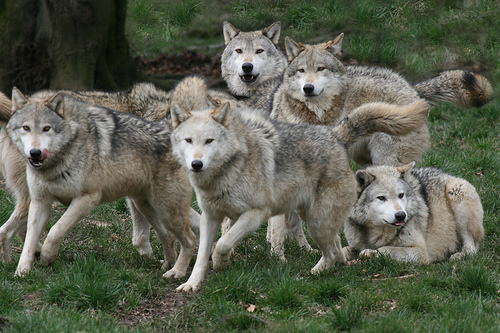Wolf Packs

-Wolves live in family groups called packs. Most
packs have about 8 members in them, but some are as big as 20.
Many zoologists believe the members of a pack remain together because
of their strong affection towards one another.
-Most packs form by a wolf leaving another pack and becoming a lone
wolf. This wolf will usually then find a mate, another lone wolf,
and then form a pack of its own. Wolf packs are formed for many
reasons: like to help provide protection and care for the young, to
help out with hunting for food, and to help defend the wolves’
territory.
-Each wolf pack has a social order called dominance hierarchy.
Every member of the pack has a certain rank in the hierarchy. The
high-ranking members, called dominant wolves, dominate the low-ranking
members of the pack, known as subordinate wolves. Everyday the
wolves of the pack show their rank to each other by using body language
when they meet. The dominant wolf stands erect, holds its tail
aloft, and points its ears up and forward. Sometimes it may even
show its teeth and growl. The subordinate wolf crouches, holds
its tail between its legs, and turns down its ears. Sometimes it
may also whine.
-Each pack lives within a specific area called a territory. The
size of a packs territory usually depends on the availability of prey
in the area. If prey is scarce, the territory may cover as much
as 800 square miles (2,100 square kilometers). If prey is
plentiful, the area may be as small as 30 square miles (77 kilometers).
-Wolves claim a territory by marking it with their scent. The
leader of the pack urinates on rocks, trees, and other objects along
the boundaries of the area. Other wolves know when they have
entered a marked territory by this scent. A pack defends its
territory and does not let other wolves hunt there. Some times
trespassing wolves are attacked and chased out of the defended
territory.
